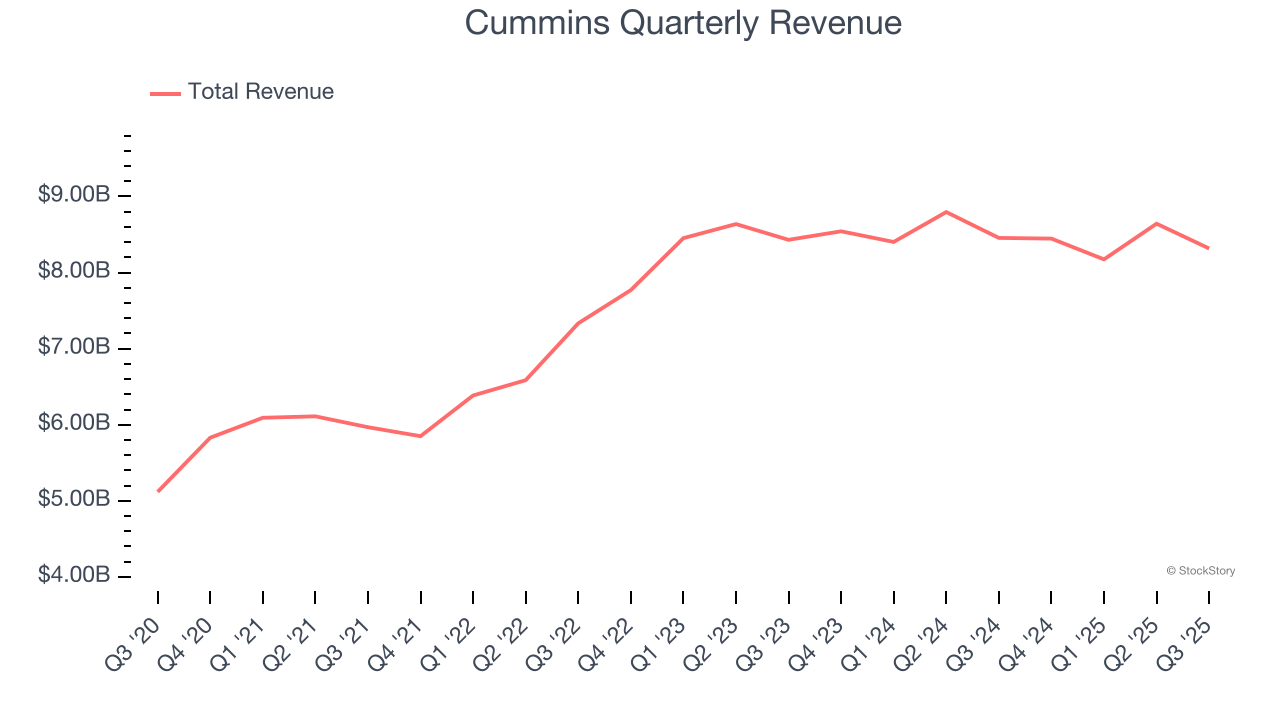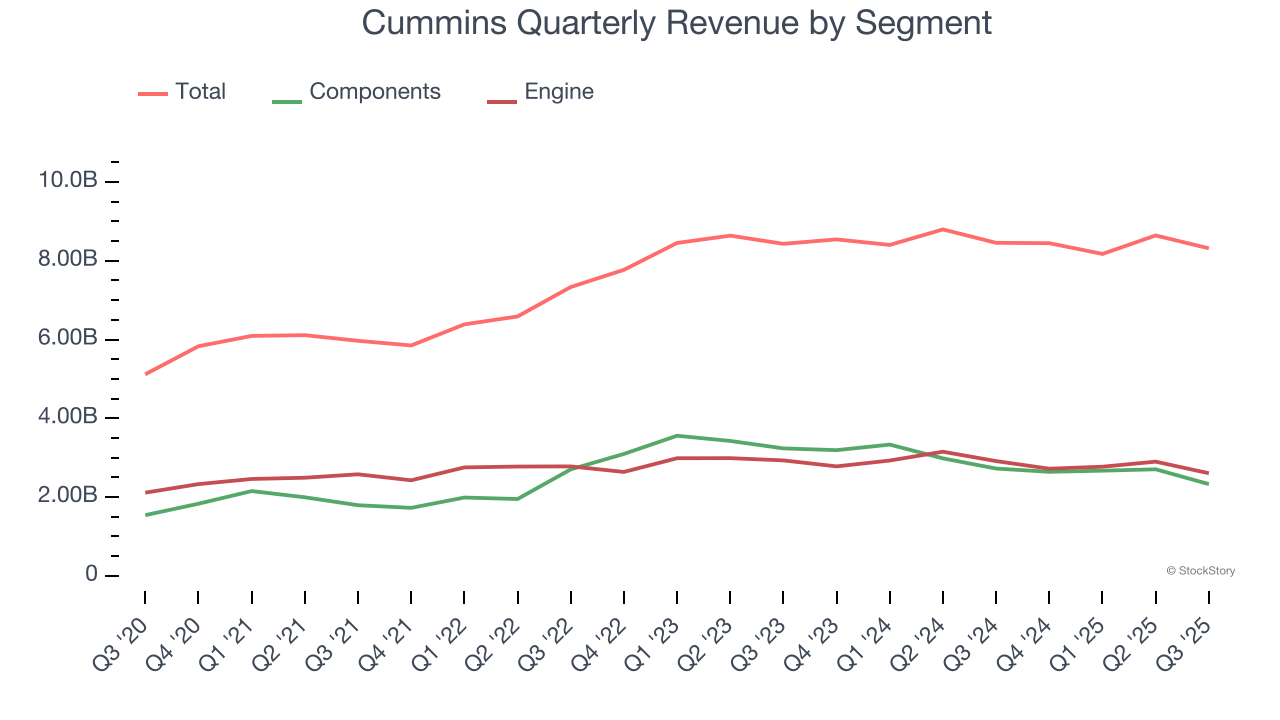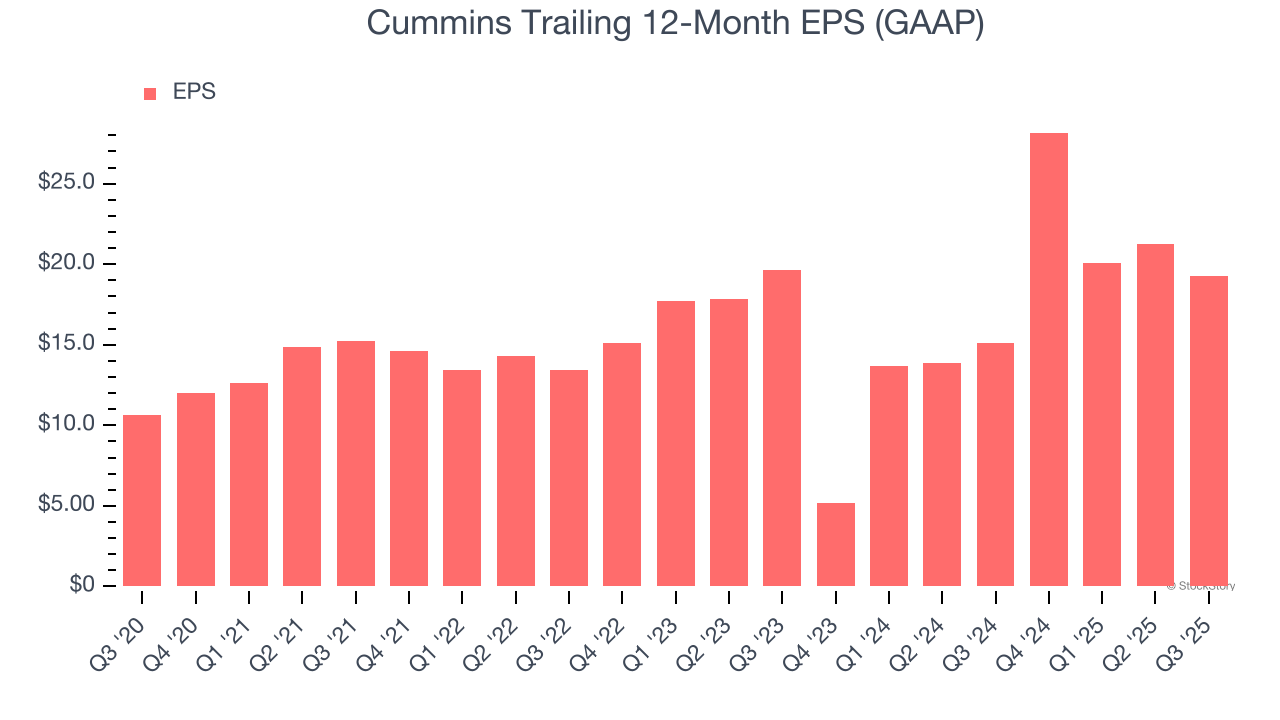
Engine manufacturer Cummins (NYSE:CMI) beat Wall Street’s revenue expectations in Q3 CY2025, but sales fell by 1.6% year on year to $8.32 billion. Its GAAP profit of $3.86 per share was 19% below analysts’ consensus estimates.
Is now the time to buy Cummins? Find out by accessing our full research report, it’s free for active Edge members.
Cummins (CMI) Q3 CY2025 Highlights:
- Revenue: $8.32 billion vs analyst estimates of $7.92 billion (1.6% year-on-year decline, 5% beat)
- EPS (GAAP): $3.86 vs analyst expectations of $4.77 (19% miss)
- Adjusted EBITDA: $1.43 billion vs analyst estimates of $1.3 billion (17.2% margin, 9.8% beat)
- Operating Margin: 10.2%, down from 12.4% in the same quarter last year
- Free Cash Flow Margin: 12.1%, up from 4.5% in the same quarter last year
- Market Capitalization: $60.51 billion
“Cummins delivered strong operating results in the third quarter, driven by profitable growth in our Power Systems and Distribution segments, due in part to continued rising demand for backup power for data centers. Effective cost management across the company helped navigate through the anticipated sharp decline in the North American truck market,” said Jennifer Rumsey, Chair and CEO.
Company Overview
With more than half of the heavy-duty truck market using its engines at one point, Cummins (NYSE:CMI) offers engines and power systems.
Revenue Growth
Reviewing a company’s long-term sales performance reveals insights into its quality. Any business can have short-term success, but a top-tier one grows for years. Over the last five years, Cummins grew its sales at an impressive 11.4% compounded annual growth rate. Its growth beat the average industrials company and shows its offerings resonate with customers.

We at StockStory place the most emphasis on long-term growth, but within industrials, a half-decade historical view may miss cycles, industry trends, or a company capitalizing on catalysts such as a new contract win or a successful product line. Cummins’s recent performance shows its demand has slowed significantly as its revenue was flat over the last two years. We also note many other Heavy Transportation Equipment businesses have faced declining sales because of cyclical headwinds. While Cummins’s growth wasn’t the best, it did do better than its peers. 
We can dig further into the company’s revenue dynamics by analyzing its most important segments, Components
and Engine
, which are 28% and 31.3% of revenue. Over the last two years, Cummins’s Components
revenue (axles, brakes, drivelines) averaged 11.6% year-on-year declines while its Engine
revenue (diesel and gas-powered engines) averaged 2.2% declines. 
This quarter, Cummins’s revenue fell by 1.6% year on year to $8.32 billion but beat Wall Street’s estimates by 5%.
Looking ahead, sell-side analysts expect revenue to remain flat over the next 12 months. This projection doesn't excite us and implies its newer products and services will not lead to better top-line performance yet.
Software is eating the world and there is virtually no industry left that has been untouched by it. That drives increasing demand for tools helping software developers do their jobs, whether it be monitoring critical cloud infrastructure, integrating audio and video functionality, or ensuring smooth content streaming. Click here to access a free report on our 3 favorite stocks to play this generational megatrend.
Operating Margin
Operating margin is a key measure of profitability. Think of it as net income - the bottom line - excluding the impact of taxes and interest on debt, which are less connected to business fundamentals.
Cummins’s operating margin has been trending up over the last 12 months and averaged 9.9% over the last five years. Its solid profitability for an industrials business shows it’s an efficient company that manages its expenses effectively. This result was particularly impressive because of its low gross margin, which is mostly a factor of what it sells and takes huge shifts to move meaningfully. Companies have more control over their operating margins, and it’s a show of well-managed operations if they’re high when gross margins are low.
Looking at the trend in its profitability, Cummins’s operating margin might fluctuated slightly but has generally stayed the same over the last five years. This raises questions about the company’s expense base because its revenue growth should have given it leverage on its fixed costs, resulting in better economies of scale and profitability.

This quarter, Cummins generated an operating margin profit margin of 10.2%, down 2.2 percentage points year on year. Since Cummins’s operating margin decreased more than its gross margin, we can assume it was less efficient because expenses such as marketing, R&D, and administrative overhead increased.
Earnings Per Share
Revenue trends explain a company’s historical growth, but the long-term change in earnings per share (EPS) points to the profitability of that growth – for example, a company could inflate its sales through excessive spending on advertising and promotions.
Cummins’s remarkable 12.7% annual EPS growth over the last five years aligns with its revenue performance. This tells us it maintained its per-share profitability as it expanded.

Like with revenue, we analyze EPS over a shorter period to see if we are missing a change in the business.
For Cummins, EPS didn’t budge over the last two years, a regression from its five-year trend. We hope it can revert to earnings growth in the coming years.
In Q3, Cummins reported EPS of $3.86, down from $5.86 in the same quarter last year. This print missed analysts’ estimates, but we care more about long-term EPS growth than short-term movements. Over the next 12 months, Wall Street expects Cummins’s full-year EPS of $19.26 to grow 10.4%.
Key Takeaways from Cummins’s Q3 Results
We were impressed by how significantly Cummins blew past analysts’ EBITDA expectations this quarter. We were also excited its revenue outperformed Wall Street’s estimates by a wide margin. On the other hand, its EPS missed. Overall, we think this was a solid quarter with some key areas of upside. The stock traded up 5.2% to $462 immediately after reporting.
Indeed, Cummins had a rock-solid quarterly earnings result, but is this stock a good investment here? The latest quarter does matter, but not nearly as much as longer-term fundamentals and valuation, when deciding if the stock is a buy. We cover that in our actionable full research report which you can read here, it’s free for active Edge members.
